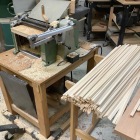In Japanese shoji work, the narrow wood strips that form the lattice to which translucent paper is applied are called “kumiko”. While the basic latticework consists of half-lapped vertical and horizontal kumiko, long ago artisans began creating panels of more complex kumiko arrangements that can be incorporated into the shoji. Interest in this type of work has blossomed in recent years in the West, where we call it simply “kumiko”.
In this two-day workshop we will create a 225mm square panel of the traditional “Asa no ha” (hemp leaf) pattern, seen here in the accompanying photos. We will prepare the basswood kumiko stock, set up the jigs used to accurately plane the various angles in the joinery, make the half-lapped square frame, and cut, fit, and assemble all the pieces that make up the Asa no ha pattern.
Students attending are asked to bring a modest set of tools for this workshop:
- 150mm (6″) steel ruler graduated in millimeters
- block plane (low angle model is best); bring two if you have them, one set very fine and the other a little more coarse
- bench chisel(s): 1/2″ or 3/4″ (12mm or 19mm) and 1/8″ (3mm)
- marking knife
- small crosscut saw – a Japanese ‘dozuki’ is preferable, but a small western saw such as a ‘Zona’ or a 6” gent’s saw will do.
- pencil(s), small square
Two-day workshop, 9:00a-5:00p daily
Tuition: $260
Materials: $ 40
—————–
Total: $300
Optional: Three jigs used to make the Asa no ha Kumiko pattern will be provided to each student for use in the class. Students can purchase all three jigs to take home for an additional fee of $75. These can be used in making many other Kumiko patterns.






